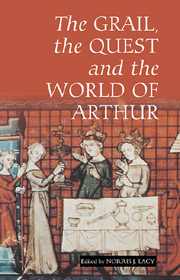Book contents
- Frontmatter
- Contents
- List of Illustrations
- Notes on Contributors
- Foreword
- Introduction: Arthur and/or the Grail
- 2 The Shape of the Grail in Medieval Art
- 3 The Crusaders' Grail
- 4 Bounds of Imagination: Grail Questing and Chivalric Colonizing in Wolfram von Eschenbach's Parzival
- 5 The Land without the Grail: A Note on Occitania, Rigaut de Barbezieux and Literary History
- 6 Female Desire and the Quest in the Icelandic Legend of Tristram and Ísodd
- 7 Questing in the Middle Dutch Lancelot Compilation
- 8 Keeping Company: Manuscript Contexts for Reading Arthurian Quest Narratives
- 9 Grail and Quest in the Medieval English World of Arthur
- 10 Malory and the Grail: The Importance of Detail
- 11 Glastonbury, the Grail-Bearer and the Sixteenth-Century Antiquaries
- 12 The Grail Quest: Where Next?
- Appendix: The Grail on Film
- Index
- Analysis of grail scenes
- Arthurian Studies
3 - The Crusaders' Grail
Published online by Cambridge University Press: 05 February 2013
- Frontmatter
- Contents
- List of Illustrations
- Notes on Contributors
- Foreword
- Introduction: Arthur and/or the Grail
- 2 The Shape of the Grail in Medieval Art
- 3 The Crusaders' Grail
- 4 Bounds of Imagination: Grail Questing and Chivalric Colonizing in Wolfram von Eschenbach's Parzival
- 5 The Land without the Grail: A Note on Occitania, Rigaut de Barbezieux and Literary History
- 6 Female Desire and the Quest in the Icelandic Legend of Tristram and Ísodd
- 7 Questing in the Middle Dutch Lancelot Compilation
- 8 Keeping Company: Manuscript Contexts for Reading Arthurian Quest Narratives
- 9 Grail and Quest in the Medieval English World of Arthur
- 10 Malory and the Grail: The Importance of Detail
- 11 Glastonbury, the Grail-Bearer and the Sixteenth-Century Antiquaries
- 12 The Grail Quest: Where Next?
- Appendix: The Grail on Film
- Index
- Analysis of grail scenes
- Arthurian Studies
Summary
Quid rides? Mutato nomine de te fabula narratur.
Horace, Satires, I, i, 69The prologue to Le Conte du Graal (henceforward, the Romance) seems to reveal that a complex combination of purposes guided the composition of the unfinished masterpiece of Chrétien de Troyes. First of all, the author was writing by command of Philip of Alsace, count of Flanders, who would have given him a ‘book’, on which, presumably, the narrative should be based. On the other hand, independently of the book's contents, he would like to please his patron, and what could be more agreeable to Philip than seeing his exploits celebrated in the new work he had ordered?
The historical circumstances offered an excellent opportunity, since the count had engaged in a campaign to which all Christian knights, especially the Franks, had been called by Pope Urban II: the Crusades. Unfortunately his participation had been less than honourable. But his misdeeds might perhaps, with the aid of poetic licence, be partly excused on grounds of juvenile innocence and lack of worldly experience. The Romance would then take the form of an inspiring fable. In the semblance of one of the characters, the count would see himself in consoling flashback, growing in skill and understanding through chivalric deeds and successive encounters with wise mentors and remarkable women. If at one point he had failed, he was being prepared to return and try again.
- Type
- Chapter
- Information
- The Grail, the Quest, and the World of Arthur , pp. 28 - 47Publisher: Boydell & BrewerPrint publication year: 2008



